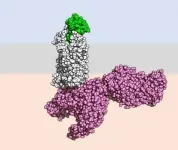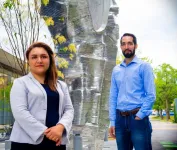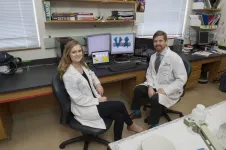Study: A quarter of adults don't want children -- and they're still happy
2021-06-16
(Press-News.org) Parenting is one of life's greatest joys, right? Not for everyone. New research from Michigan State University psychologists examines characteristics and satisfaction of adults who don't want children.
As more people acknowledge they simply don't want to have kids, Jennifer Watling Neal and Zachary Neal, both associate professors in MSU's department of psychology, are among the first to dive deeper into how these "child-free" individuals differ from others.
"Most studies haven't asked the questions necessary to distinguish 'child-free' individuals -- those who choose not to have children -- from other types of nonparents," Jennifer Watling Neal said. "Nonparents can also include the 'not-yet-parents' who are planning to have kids, and 'childless' people who couldn't have kids due to infertility or circumstance. Previous studies simply lumped all nonparents into a single category to compare them to parents."
The study -- published June 16 in PLOS ONE -- used a set of three questions to identify child-free individuals separately from parents and other types of nonparents. The researchers used data from a representative sample of 1,000 adults who completed MSU's State of the State Survey, conducted by the university's Institute for Public Policy and Social Research.
"After controlling for demographic characteristics, we found no differences in life satisfaction and limited differences in personality traits between child-free individuals and parents, not-yet-parents, or childless individuals," Zachary Neal said. "We also found that child-free individuals were more liberal than parents, and that people who aren't child-free felt substantially less warm toward child-free individuals."
Beyond findings related to life satisfaction and personality traits, the research unveiled additional unexpected findings.
"We were most surprised by how many child-free people there are," Jennifer Watling Neal said. "We found that more than one in four people in Michigan identified as child-free, which is much higher than the estimated prevalence rate in previous studies that relied on fertility to identify child-free individuals. These previous studies placed the rate at only 2% to 9%. We think our improved measurement may have been able to better capture individuals who identify as child-free."
Given the large number of child-free adults in Michigan, more attention needs to be paid to this group, the researchers said. For example, the researchers explained that their study only included one time point, so didn't examine when people decided to be child-free -- however, they hope forthcoming research will help the public understand both when people start identifying as child-free as well as the factors that lead to this choice.
INFORMATION:
(Note for media: Please include the following link to the study in all online media coverage: https://journals.plos.org/plosone/article?id=10.1371/journal.pone.0252528)
Michigan State University has been working to advance the common good in uncommon ways for more than 165 years. One of the top research universities in the world, MSU focuses its vast resources on creating solutions to some of the world's most pressing challenges, while providing life-changing opportunities to a diverse and inclusive academic community through more than 200 programs of study in 17 degree-granting colleges.
For MSU news on the Web, go to MSUToday. Follow MSU News on Twitter at twitter.com/MSUnews.
[Attachments] See images for this press release:

ELSE PRESS RELEASES FROM THIS DATE:
2021-06-16
Chemokine receptors, located at the surface of many immune cells, play an important role in their function. Chemokines are small proteins that bind to these receptors and control the movement and behaviour of white blood cells. However, despite the importance of this family of receptors, their activation mechanism remains poorly understood. In Switzerland, a research consortium from the University of Geneva (UNIGE), the Biozentrum of the University of Basel, and the Paul Scherrer Institute (PSI) in Villigen has succeeded in decoding the activation mechanism of the CCR5 receptor, a member of this family implicated in several diseases such as HIV/AIDS, cancer, and the respiratory ...
2021-06-16
New research published this week challenges a popular belief that intermittent fasting diets such as alternate day fasting or the '5:2' are the most effective ways to lose weight.
Over recent years, diets which see people fast on a few days each week have increased in popularity, reinforced by images of people's miraculous weight transformations, and backed by celebrity endorsements.
However, evidence to date about the effectiveness of fasting compared with more traditional diets which aim to reduce calorie intake over the course of a full week has been limited.
Published in the prestigious journal Science Translational Medicine, the new study from a team of physiologists at the University of Bath builds this evidence and indicates that there is 'nothing ...
2021-06-16
PHILADELPHIA (June 16, 2021) - The current Medicare reimbursement policy for nurse practitioners (NPs) allows NPs to directly bill Medicare for services that they perform, but they are reimbursed at only 85% of the physician rate. A growing number of states are granting full practice authority to nurse practitioners. Even more states have loosened practice restrictions due to COVID-19. Both of these reasons illustrate why payment parity is essential.
In an article in The Online Journal of Issues in Nursing, Alycia Bischof, MSN, APRN, PNP-BC, Senior Lecturer at the ...
2021-06-16
The long relationships between stars and the planets around them - including the Sun and the Earth - may be even more complex than previously thought. This is one conclusion of a new study involving thousands of stars using NASA's Chandra X-ray Observatory.
By conducting the largest survey ever of star-forming regions in X-rays, a team of researchers has helped outline the link between very powerful flares, or outbursts, from youthful stars, and the impact they could have on planets in orbit.
"Our work tells us how the Sun may have behaved and affected ...
2021-06-16
An international team of physicists led by the University of Minnesota has discovered that a unique superconducting metal is more resilient when used as a very thin layer. The research is the first step toward a larger goal of understanding unconventional superconducting states in materials, which could possibly be used in quantum computing in the future.
The collaboration includes four faculty members in the University of Minnesota's School of Physics and Astronomy--Associate Professor Vlad Pribiag, Professor Rafael Fernandes, and Assistant Professors Fiona Burnell and Ke Wang--along with physicists ...
2021-06-16
Clinical research on COVID-19 has boomed in the 18 months since the disease first appeared. Countless papers have looked at the topic from almost every possible angle, including methods of detection.
For a new paper published in the journal END ...
2021-06-16
RIVERSIDE, Calif. -- Supermassive black holes, or SMBHs, are black holes with masses that are several million to billion times the mass of our sun. The Milky Way hosts an SMBH with mass a few million times the solar mass. Surprisingly, astrophysical observations show that SMBHs already existed when the universe was very young. For example, a billion solar mass black holes are found when the universe was just 6% of its current age, 13.7 billion years. How do these SMBHs in the early universe originate?
A team led by a theoretical physicist at the University of California, Riverside, has come up with an explanation: a massive seed black hole that the collapse of a dark matter halo could produce.
Dark matter halo is the halo of invisible matter ...
2021-06-16
RESEARCH TRIANGLE PARK, N.C. -- A new approach to studying conjugated polymers made it possible for an Army-funded research team to measure, for the first time, the individual molecules' mechanical and kinetic properties during polymerization reaction. The insights gained could lead to more flexible and robust soft electronic materials, such as health monitors and soft robotics.
Conjugated polymers are essentially clusters of molecules strung along a backbone that can conduct electrons and absorb light. This makes them a perfect fit for creating soft optoelectronics, such as wearable electronic devices; however, as flexible as they are, these polymers are difficult to study in bulk because they aggregate ...
2021-06-16
DALLAS (SMU) -- A team of SMU biological scientists has confirmed that P-glycoprotein (P-gp) has the ability to remove a toxin from the brain that is associated with Alzheimer's disease.
The finding could lead to new treatments for the disease that affects nearly 6 million Americans. It was that hope that motivated lead researchers James W. McCormick and Lauren Ammerman to pursue the research as SMU graduate students after they both lost a grandmother to the disease while at SMU.
In the Alzheimer's brain, abnormal levels of amyloid-β proteins clump together to form plaques that collect between neurons and can disrupt cell function. ...
2021-06-16
Why can some people weather the stress of social isolation better than others, and what implications does this have for their health? New research from the Communication Neuroscience Lab at the Annenberg School for Communication at the University of Pennsylvania found that people who felt a strong sense of purpose in life were less lonely during the COVID-19 pandemic. Did they achieve less loneliness by flouting public health guidance? No. Although lonelier people were less likely to want to follow public health guidance, people with a stronger sense of purpose also expressed more willingness to engage in social distancing, hand washing, and other ...
LAST 30 PRESS RELEASES:
[Press-News.org] Study: A quarter of adults don't want children -- and they're still happy








